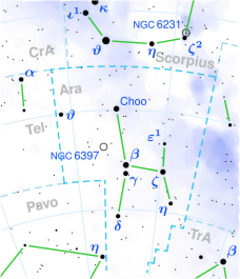Astronomy:Beta Arae
| Observation data Equinox J2000.0]] (ICRS) | |
|---|---|
| Constellation | Ara |
| Right ascension | 17h 25m 17.989s[1] |
| Declination | −55° 31′ 47.57″[1] |
| Apparent magnitude (V) | 2.84[2] |
| Characteristics | |
| Evolutionary stage | Red supergiant |
| Spectral type | K0/1Ib[3] |
| U−B color index | +1.56[4] |
| B−V color index | +1.46[4] |
| Astrometry | |
| Radial velocity (Rv) | −0.3±0.2[5] km/s |
| Proper motion (μ) | RA: −8.51[6] mas/yr Dec.: −25.24[6] mas/yr |
| Parallax (π) | 4.5601 ± 0.2077[1] mas |
| Distance | 714+39 −34 ly (218.8+12.0 −10.4 pc) |
| Absolute magnitude (MV) | −3.494[7] |
| Details[8] | |
| Mass | 5.89±0.07 or 7.89±0.4 M☉ |
| Radius | 141.4±6.6 R☉ |
| Luminosity | 5,774±535 L☉ |
| Surface gravity (log g) | 0.97±0.06 cgs |
| Temperature | 4,232±17 K |
| Metallicity [Fe/H] | 0.5±0.1 dex |
| Rotational velocity (v sin i) | 5.4±1.0[5] km/s |
| Age | 50.1±4.4[9] Myr |
| Other designations | |
| Database references | |
| SIMBAD | data |
Beta Arae is the brightest star in the constellation of Ara. This is a very luminous, relatively young red supergiant with an apparent visual magnitude of 2.84 and an absolute magnitude of −3.494.[2][7] Its name is a Bayer designation that is Latinized from β Arae, and abbreviated Beta Ara or β Ara. Based on a photogeometric estimation method, it is 710 light-years away,[11] a distance of which interstellar extinction in the line of sight reduces its apparent magnitude by 0.193 magnitudes.[8]
Characteristics
The spectrum of this star matches a stellar classification of K0/1 Ib,[3] with the luminosity class notation 'Ib' indicating that the star is a supergiant. It has an age estimated at 50 million years,[9] having spent much of its life as a B-type star.[12] Currently, it has expanded to 141 times the Sun's size and is 5,800 times more luminous.[8] Beta Arae is radiating energy from its outer envelope at an effective temperature of 4,200 K, which causes it to take on the orange hue of a K-type star.[13] This enlarged star appears to be rotating slowly with a projected rotational velocity of about 5 km/s.[5] The abundance of elements other than hydrogen and helium, its metallicity, is more than three times that of the Sun.[5][lower-alpha 1]
Nomenclature
Beta Arae is the star's Bayer designation. Other designations include HD 157244 (from the Henry Draper Catalogue), HIP 85258 (from the Hipparcos catalogue) and HR 6461 (from the Bright Star Catalogue).[10]
Rarely, this star is called Vasat-ül-cemre a Turkisation of Arabic وسط الجمر (wasaṭ al-jamar), meaning "middle of the embers."[14] The constellation is named in Arabic المجمرة (al-mijmarah), meaning brazier/incense-burner.[15] In Chinese, 杵 (Chǔ), meaning Pestle, refers to an asterism of β, σ and α Arae.[16] The Chinese name for β Arae is 杵三 (Chǔ sān, English: the Third Star of Pestle.)[17]
Notes
- ↑ The abundance is estimated by taking [Fe/H] to the power of ten:
10[Fe/H] = 10+0.5 = 3.1
References
- ↑ 1.0 1.1 1.2 Brown, A. G. A. (2021). "Gaia Early Data Release 3: Summary of the contents and survey properties". Astronomy & Astrophysics 649: A1. doi:10.1051/0004-6361/202039657. Bibcode: 2021A&A...649A...1G. Gaia EDR3 record for this source at VizieR.
- ↑ 2.0 2.1 Wielen, R. et al. (1999). "Sixth Catalogue of Fundamental Stars (FK6). Part I. Basic fundamental stars with direct solutions". Veröff. Astron. Rechen-Inst. Heidelb (Astronomisches Rechen-Institut Heidelberg) 35 (35): 1. Bibcode: 1999VeARI..35....1W.
- ↑ 3.0 3.1 Houk, N.; Cowley, A. P. (1994-11-01). "VizieR Online Data Catalog: Michigan catalogue for the HD stars, vol. 1 (Houk+, 1975)". VizieR Online Data Catalog 3031: III/31B. Bibcode: 1994yCat.3031....0H. Beta Arae's database entry at VizieR.
- ↑ 4.0 4.1 Johnson, H. L. et al. (1966). "UBVRIJKL photometry of the bright stars". Communications of the Lunar and Planetary Laboratory 4 (99): 99. Bibcode: 1966CoLPL...4...99J.
- ↑ 5.0 5.1 5.2 5.3 De Medeiros, J. R. et al. (November 2002). "A catalog of rotational and radial velocities for evolved stars. II. Ib supergiant stars". Astronomy and Astrophysics 395 (1): 97–98. doi:10.1051/0004-6361:20021214. Bibcode: 2002A&A...395...97D.
- ↑ van Leeuwen, F. (November 2007). "Validation of the new Hipparcos reduction". Astronomy and Astrophysics 474 (2): 653–664. doi:10.1051/0004-6361:20078357. Bibcode: 2007A&A...474..653V.
- ↑ 7.0 7.1 Cassatella, A. et al. (2001). "On the Wilson-Bappu relationship in the Mg II k line". Astronomy and Astrophysics 374 (3): 1085–1091. doi:10.1051/0004-6361:20010816. Bibcode: 2001A&A...374.1085C.
- ↑ 8.0 8.1 8.2 Soubiran, C. et al. (2024-02-01). "Gaia FGK benchmark stars: Fundamental Teff and log g of the third version". Astronomy and Astrophysics 682: A145. doi:10.1051/0004-6361/202347136. ISSN 0004-6361. Bibcode: 2024A&A...682A.145S. Beta Arae's database entry at VizieR.
- ↑ 9.0 9.1 Tetzlaff, N. et al. (January 2011). "A catalogue of young runaway Hipparcos stars within 3 kpc from the Sun". Monthly Notices of the Royal Astronomical Society 410 (1): 190–200. doi:10.1111/j.1365-2966.2010.17434.x. Bibcode: 2011MNRAS.410..190T.
- ↑ 10.0 10.1 "bet Ara". SIMBAD. Centre de données astronomiques de Strasbourg. http://simbad.u-strasbg.fr/simbad/sim-basic?Ident=bet+Ara.
- ↑ Bailer-Jones, C. A. L. et al. (2021-03-01). "Estimating distances from parallaxes. V: Geometric and photogeometric distances to 1.47 billion stars in Gaia Early Data Release 3". The Astronomical Journal 161 (3): 147. doi:10.3847/1538-3881/abd806. ISSN 0004-6256. Bibcode: 2021AJ....161..147B. Data about this star can be seen here.
- ↑ Kaler, James B.. "BETA ARA (Beta Arae)". Stars. University of Illinois. http://stars.astro.illinois.edu/sow/betaara.html. Retrieved 2012-01-15.
- ↑ "The Colour of Stars". Australia Telescope, Outreach and Education. Commonwealth Scientific and Industrial Research Organisation. December 21, 2004. Archived from the original on 2012-03-18. https://web.archive.org/web/20120318151427/http://outreach.atnf.csiro.au/education/senior/astrophysics/photometry_colour.html. Retrieved 2012-01-16.
- ↑ "YILDIZ ADLARI SÖZLÜĞÜ". http://www.pultar.org/~mustafa/YAS/V.html#VasatUlCemre. Retrieved 2020-03-04.
- ↑ "Ara". https://sites.google.com/site/urjuzatalkawakib/ara. Retrieved 2020-03-04.
- ↑ 陳久金 (2005). 中國星座神話. Wunan Book Publishing Co.. ISBN 978-986-7332-25-7. https://books.google.com/books?id=0Vex0rYzdu8C.
- ↑ "天文教育資訊網". 2006-07-01. http://aeea.nmns.edu.tw/2006/0607/ap060701.html. Retrieved 2020-03-04.
External links
 |

